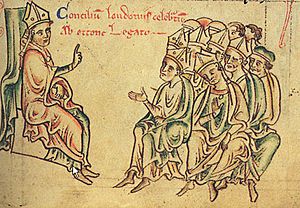Synods of Westminster facts for kids
The Synods of Westminster were important meetings of church leaders. These meetings, also called councils, took place in and around London. Most of these medieval meetings happened at places like St Paul's, Westminster Abbey, or Lambeth.
These councils were different types of gatherings. Some were for a specific area, while others were for the whole country. For many centuries, the main church meetings held here were called convocations of the province of Canterbury.
Contents
Early Church Meetings in London
The 11th Century: New Rules for Bishops
One of the first big councils happened at St Paul's in 1075. A leader named Lanfranc was in charge. This meeting brought back old rules. It also said that bishops could not buy or sell church positions. Plus, three bishops were allowed to move their main churches to bigger cities like Salisbury, Chichester, and Chester.
The 12th Century: Changes for Clergy
In 1102, a national meeting took place at Westminster. Anselm of Canterbury led this council. They made rules against buying church jobs and against priests getting married. They also spoke out against slavery.
Other councils in 1126, 1127, and 1138 were led by special representatives from the Pope. The 1175 meeting was for a specific church area. Their rules, which often repeated older ones, show us what life was like for church officials back then. The rules from 1200 were largely based on ideas from a big church meeting in 1179.
Important Councils from the 13th to 15th Centuries
At St Paul's, new church laws were announced in 1237 and 1268. These were very important national councils. A meeting at Lambeth in 1281 created rules that King Edward I did not like much. These rules included a detailed plan for teaching people about religion.
For the next 200 years, many councils focused on stopping ideas they called heresy (beliefs that went against church teachings).
- In 1286, a meeting rejected eight ideas about the body of Christ after his death.
- In 1291, a council at Westminster supported the expulsion of Jewish people from England.
- In 1382, ten ideas from John Wyclif, a religious reformer, were condemned.
- In 1396, eighteen more of Wyclif's ideas were also rejected at St Paul's.
- In 1413, John Oldcastle, another religious reformer, was condemned at St Paul's.
During the 1300s, councils at St Paul's also looked at how church officials managed money and how they behaved. They made many rules about their clothes and conduct in 1328, 1342, 1343, and 1463.
Later Church Meetings
From the time of King Edward VI onwards, many big changes in church rules happened at St Paul's and Westminster Abbey. Some of the most important meetings were in 1547, 1552, 1554, 1562, 1571, 1604, 1605, 1640, and 1661.
In 1852, the first of a new series of councils took place. These were for the newly formed Catholic archdiocese of Westminster. For information on larger Anglican church meetings, you can look up Lambeth Conferences.


